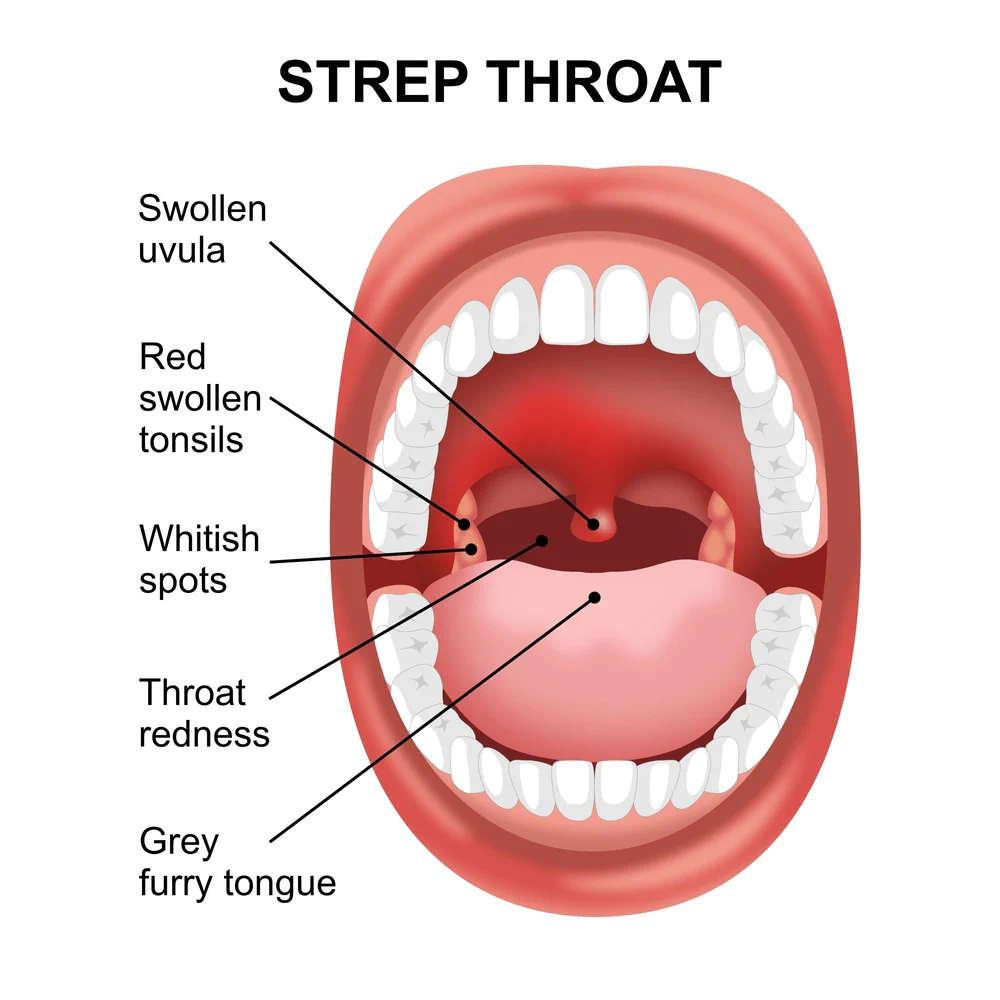Mono Throat vs Strep Throat: What’s the Difference?
Conditions
•
Sep 10, 2024

Waking up with a sore throat can be miserable, leaving you wondering if it’s just a minor irritation or something more serious. Two common culprits behind severe sore throats are mononucleosis (mono) and strep throat. While they share some symptoms, these conditions have distinct differences:
- Cause: Mono is caused by a virus, while strep throat is caused by bacteria
- Duration: Mono symptoms typically last longer (weeks to months) compared to strep (days to weeks)
- Additional symptoms: Mono often involves fatigue and swollen lymph nodes, while strep may cause fever and difficulty swallowing
- Treatment: Strep throat is treated with antibiotics, whereas mono requires rest and supportive care
In this article, we’ll lay out the characteristics of mono throat vs. strep throat, comparing their symptoms, diagnosis methods, and treatment options, so that you can get on the quick road to recovery.
Cause
Mononucleosis, commonly known as mono, is caused by the Epstein-Barr virus (EBV), which belongs to the herpes virus family. While EBV is responsible for about 90% of mono cases, other viruses, like cytomegalovirus, can occasionally cause similar symptoms. EBV is often called the “kissing disease” because it spreads through saliva, but it can also be spread through other bodily fluids and close contact.
Strep throat, on the other hand, is a bacterial infection caused by group A Streptococcus bacteria. These bacteria are highly contagious and can spread through respiratory droplets when an infected person coughs or sneezes or through direct contact with infected individuals. This bacteria can also live on often-touched surfaces like doorknobs, allowing it to spread indirectly.
Learn the difference between tonsillitis vs strep throat
Duration
How long can mono stay in your system? Mono typically lasts longer than strep throat. The initial symptoms of mono, such as sore throat and fever, usually last for 2-4 weeks; however, some people can still experience fatigue for up to several months — sometimes up to six months or more in severe cases. The symptoms may come and go over time, where you might feel better for a bit, then worse again.
Strep throat usually resolves more quickly than mono, especially with proper treatment. Symptoms typically begin to improve within 24-48 hours of starting antibiotics. Without treatment, strep throat symptoms may last 3-7 days. However, even after symptoms subside, it’s crucial to complete the full course of antibiotics (usually 10 days) to prevent complications and reduce the risk of spreading the infection.
Additional symptoms
While both conditions cause sore throat, they have distinct symptom profiles:
Mono symptoms often include:
- Extreme fatigue
- Swollen lymph nodes, particularly in the neck and armpits
- Enlarged spleen, which can cause abdominal pain
- Fever (Learn about treating fevers in children)
- Headache
- Body aches
- Skin rash in some cases (referred to as “mono rash”)

As seen in this mononucleosis rash picture, the rash is characterized by small, red, non-itchy spots typically appearing on the chest or abdomen.
Strep throat commonly presents with:
- Sudden onset of sore throat
- Difficulty swallowing
- High fever, often 101°F (38.3°C) or higher
- Red and swollen tonsils, sometimes with white patches
- Tiny red spots on the roof of the mouth
- Swollen lymph nodes in the neck

As shown in this strep throat picture, the tonsils are red and swollen, often with white streaks or spots. The back of the throat may appear bright red.
While both mono and strep throat typically resolve with proper care, it’s important to seek emergency treatment for fever with a sore throat if the fever is above 103°F, if you’re having difficulty breathing or swallowing, or if there are signs of dehydration.
Treatment
For both mono and strep throat, getting a proper diagnosis through a physical exam and lab tests is key to finding the right treatment. Even though these conditions may share some symptoms, accurate diagnosis is important because their causes and treatments are different.
Mono, being a viral infection, doesn’t respond to antibiotics. So, does mono go away on its own? Yes, mononucleosis typically goes away on its own. Therefore, treatment focuses on managing symptoms and supporting the body’s immune response by incorporating:
- Rest (many need several weeks of reduced activity)
- Hydration
- Over-the-counter pain relievers like acetaminophen or ibuprofen
- Salt water gargle
- Avoiding contact sports and strenuous activities for at least four weeks
- In severe cases, corticosteroids may be prescribed to reduce throat and tonsil swelling
If you suspect you have mono, it’s important to note that antibiotics like amoxicillin can cause a distinctive rash and should be avoided.
Strep throat, as a bacterial infection, is primarily treated with:
- Antibiotics, usually penicillin or amoxicillin. For those allergic to penicillin, alternatives like erythromycin or clarithromycin may be used
- Over-the-counter pain relievers for symptom management
- Rest and hydration
- Saltwater gargles or throat lozenges for sore throat relief
- Soft, cool foods if swallowing is difficult
It’s important to finish your full round of antibiotics for strep throat, even if you start feeling better, to avoid complications like rheumatic fever or kidney issues. Keep in mind that after 24 hours of taking antibiotics, you’re usually no longer contagious and can return to school or work if you feel up to it.
How can you tell the difference between mono and strep?
When comparing mono vs. strep, there are several key distinctions that can help you figure out which you’re dealing with:
- Onset and duration: Strep symptoms usually appear suddenly and resolve within a week, especially with treatment. A throat with mono tends to worsen gradually, and symptoms can last for weeks or months.
- Fever: Strep often causes a high fever (over 101°F), while mono typically presents with a lower-grade fever.
- Fatigue: Extreme, prolonged fatigue is characteristic of mono but less common with strep.
- Throat appearance: Strep often shows red, swollen tonsils with white patches. A throat with mono may be red and swollen but usually lacks distinct white patches.
- Additional symptoms: Mono frequently causes swollen lymph nodes and an enlarged spleen, which are less common in strep.
- Age group: Mono is more common in teenagers and young adults, while strep can affect all age groups but is more frequent in children.
- Response to antibiotics: Strep improves quickly with antibiotic treatment, while antibiotics don’t affect mono symptoms.
- Diagnostic tests: A rapid strep test or throat culture can confirm strep, while blood tests for antibodies or the presence of abnormal white blood cells (atypical lymphocytes) can indicate mono.
Remember, a definitive diagnosis of mono throat vs. strep throat requires proper medical evaluation, as some symptoms can overlap. If you’re unsure, it’s best to consult a healthcare provider for accurate diagnosis and appropriate treatment.
Dealing with a painful, sore throat? Visit a Complete Care freestanding ER!
While both mono and strep throat can cause severe sore throats, they differ significantly in their causes, duration, and treatment approaches, making professional medical diagnosis crucial for proper care.
If you’re experiencing persistent fatigue and swollen lymph nodes that might be mono, or sudden severe throat pain and fever that could be strep, it’s important to seek prompt medical attention at a Complete Care freestanding ER for an accurate diagnosis and effective treatment.
When faced with symptoms of mono throat vs. strep throat or concerns about your kids getting sick, our facilities are equipped to perform rapid strep tests, mono spot tests, and other necessary diagnostics on-site, offering you swift and accurate diagnoses.
With locations across Texas (Austin, Corpus Christi, Dallas/Fort Worth, East Texas, Lubbock, and San Antonio) and in Colorado Springs, you have 24/7 access to excellent medical care when you need it, where you need it.
More Helpful Articles by Complete Care:
